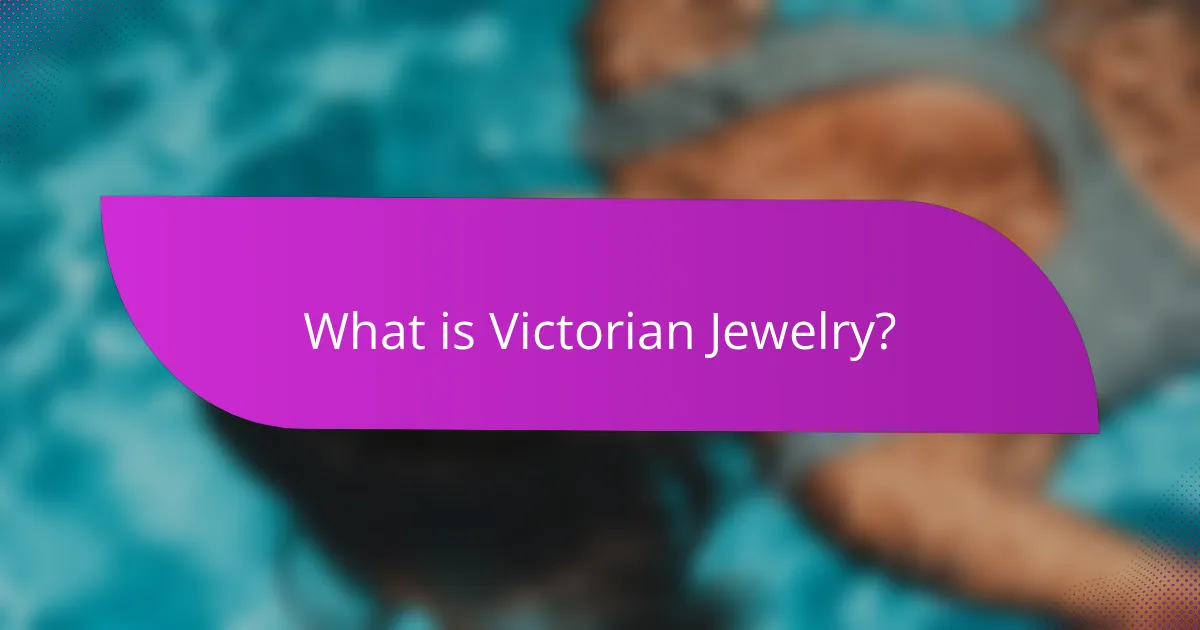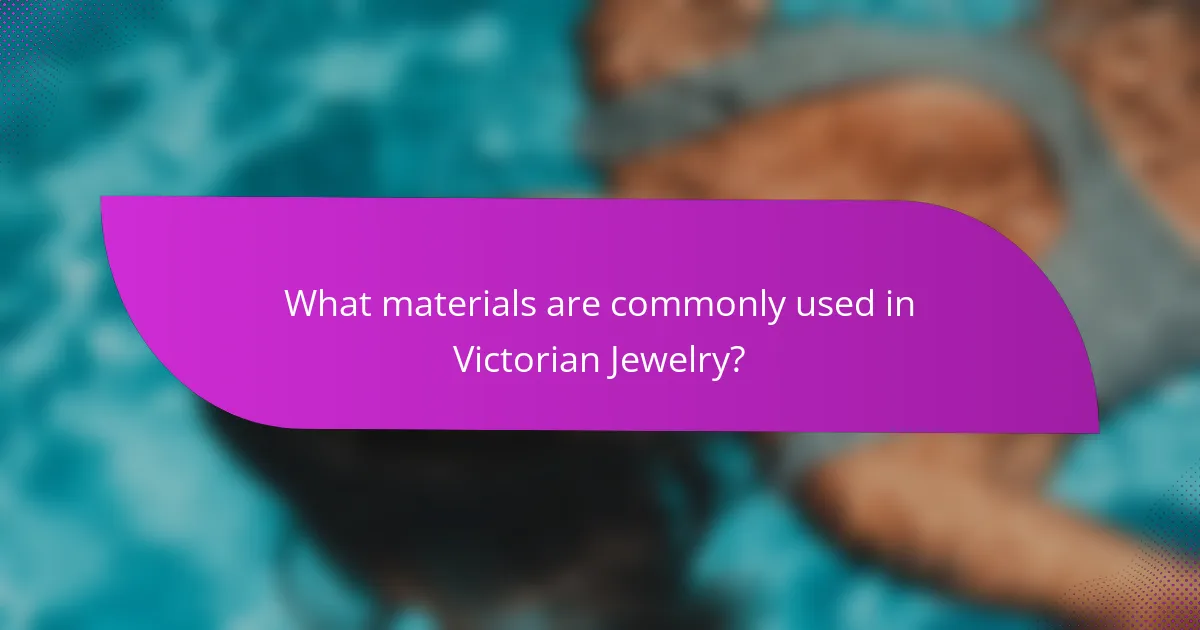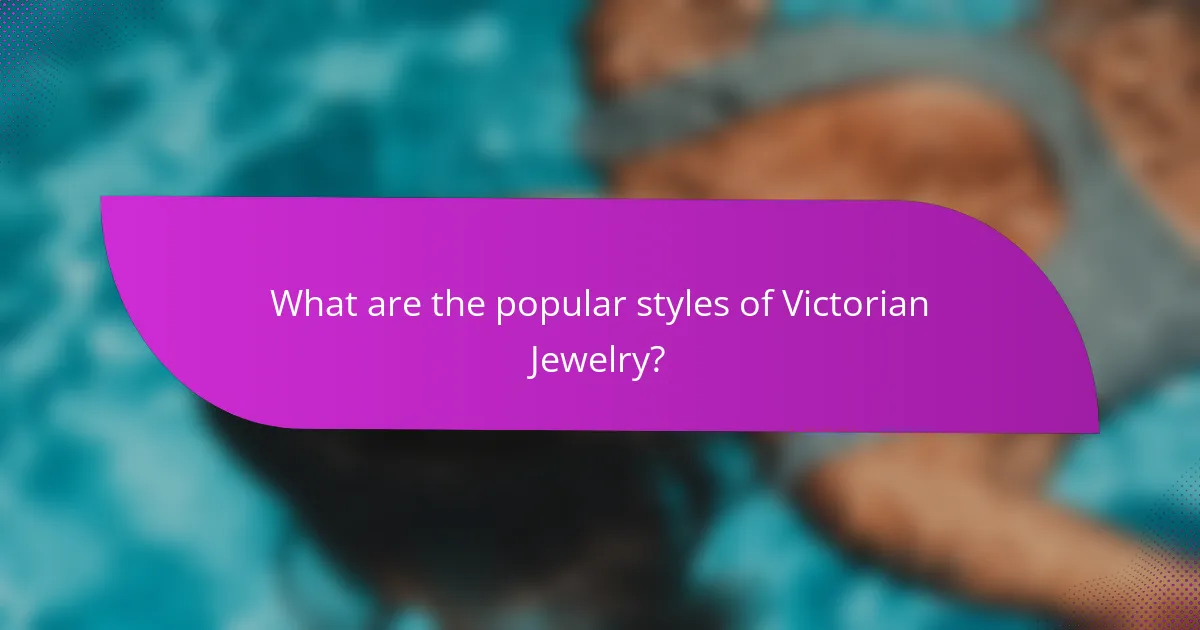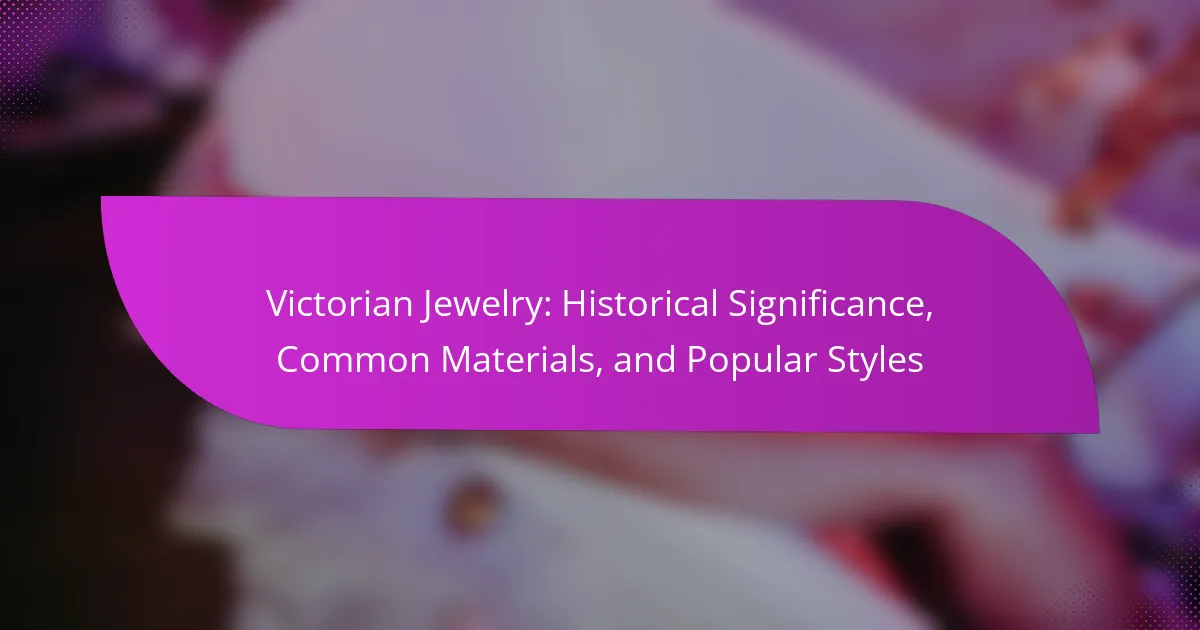Victorian jewelry encompasses decorative items crafted during Queen Victoria’s reign from 1837 to 1901, marked by elaborate designs and intricate craftsmanship. This jewelry commonly features materials such as gold, silver, and various gemstones, including diamonds and pearls, which symbolize personal sentiment and social status. Key styles include Romantic, Aesthetic, and Gothic Revival, each reflecting the cultural values and artistic movements of the era. Notable forms of Victorian jewelry include mourning pieces and sentimental items, which convey affection and commemorate loved ones. The enduring popularity of Victorian jewelry highlights its historical significance and aesthetic appeal.

What is Victorian Jewelry?
Victorian jewelry refers to decorative items made during the reign of Queen Victoria from 1837 to 1901. This era is characterized by elaborate designs and intricate craftsmanship. Common materials include gold, silver, and gemstones like diamonds and pearls. Victorian jewelry often features motifs such as flowers, hearts, and cameos. The use of symbolism was prevalent, reflecting personal sentiments and social status. Notable styles include mourning jewelry, which commemorated deceased loved ones, and sentimental pieces that conveyed affection. The popularity of Victorian jewelry continues today, celebrated for its historical significance and aesthetic appeal.
How did Victorian Jewelry evolve during the Victorian era?
Victorian jewelry evolved significantly throughout the Victorian era. It began with simple designs in the early years, influenced by Romanticism. As the era progressed, jewelry became more ornate and elaborate. The introduction of new materials, such as gold and gemstones, played a crucial role. The mid-Victorian period saw the rise of sentimental jewelry, including lockets and mourning pieces. By the late Victorian era, styles reflected a mix of historical influences, including Gothic and Renaissance elements. The Industrial Revolution also allowed for mass production, making jewelry more accessible. Overall, Victorian jewelry mirrored the social and cultural changes of the time.
What historical events influenced the design of Victorian Jewelry?
The design of Victorian jewelry was influenced by several historical events. The Industrial Revolution played a significant role by enabling mass production of jewelry. This period saw advancements in technology, which allowed for intricate designs at lower costs. The death of Prince Albert in 1861 deeply affected Queen Victoria, leading to a trend of mourning jewelry. The Great Exhibition of 1851 showcased global craftsmanship, inspiring Victorian jewelers to incorporate exotic materials and styles. The rise of the middle class also impacted jewelry design, as more people sought affordable yet fashionable pieces. Additionally, the discovery of new gemstones and mining techniques expanded the variety of materials used in jewelry. These events collectively shaped the aesthetics and accessibility of Victorian jewelry.
How did social changes impact the popularity of Victorian Jewelry?
Social changes significantly increased the popularity of Victorian jewelry. The period saw a rise in the middle class due to the Industrial Revolution. This economic shift allowed more people to afford decorative items. Jewelry became a symbol of status and wealth. The Victorian era also emphasized sentimentalism, leading to jewelry with personal meanings. Common motifs included locks of hair and engraved messages. Additionally, the mourning customs of Queen Victoria influenced jewelry styles. Mourning jewelry became popular after her husband’s death in 1861. These social factors collectively drove the demand for Victorian jewelry.
What are the key characteristics of Victorian Jewelry?
Victorian jewelry is characterized by intricate designs, symbolic motifs, and diverse materials. It often features floral patterns, cameos, and gemstones. The period spans from 1837 to 1901, coinciding with Queen Victoria’s reign. Jewelry pieces were made using gold, silver, and precious stones like diamonds and pearls. Mourning jewelry became popular, reflecting societal customs around death. Additionally, the use of enamel and intricate metalwork is common in this style. Victorian jewelry often incorporates sentimental elements, such as lockets and hair jewelry, signifying personal connections. Overall, the key characteristics reflect both artistry and emotional significance.
What design elements are commonly found in Victorian Jewelry?
Victorian jewelry commonly features intricate designs, including floral motifs and naturalistic elements. These designs often incorporate symbolic meanings, reflecting the sentimental values of the era. Popular materials include gold, silver, and gemstones, such as diamonds and pearls. Additionally, Victorian jewelry frequently showcases techniques like engraving and enameling. The use of cameos and lockets was also prevalent, emphasizing personalization. This style often includes ornate settings and detailed craftsmanship, characteristic of the Victorian period’s artistic movements.
How does Victorian Jewelry reflect the values of its time?
Victorian jewelry reflects the values of its time by emphasizing sentimentality, social status, and craftsmanship. During the Victorian era, from 1837 to 1901, jewelry often symbolized personal relationships and emotions. Common motifs included hearts, flowers, and intricate designs, showcasing a deep connection to nature and love. Additionally, jewelry served as status symbols, with materials like gold, diamonds, and rare gemstones indicating wealth and class. The use of mourning jewelry, such as lockets containing hair, highlighted the Victorian emphasis on grief and remembrance. Craftsmanship was highly valued, with artisans creating detailed pieces that demonstrated skill and artistry. Overall, Victorian jewelry encapsulated the era’s cultural norms and social values.

What materials are commonly used in Victorian Jewelry?
Victorian jewelry commonly uses materials such as gold, silver, and gemstones. Gold was favored for its durability and luster. Silver was often used for its affordability and versatility. Gemstones like diamonds, emeralds, and sapphires were popular for their beauty and symbolism. Additionally, materials like pearls and enamel were frequently incorporated. Pearls represented purity, while enamel provided vibrant colors and intricate designs. These materials reflect the craftsmanship and aesthetic values of the Victorian era.
What are the primary metals used in Victorian Jewelry?
The primary metals used in Victorian jewelry are gold, silver, and platinum. Gold was favored for its malleability and luster, making it ideal for intricate designs. Silver was commonly used due to its affordability and availability. Platinum emerged later in the Victorian era, valued for its strength and rarity. These metals were often combined with gemstones to enhance the jewelry’s aesthetic appeal. Historical records indicate that gold and silver were widely used in various forms, including brooches, necklaces, and rings during the Victorian period.
How does gold content vary in Victorian Jewelry pieces?
Gold content in Victorian jewelry pieces varies significantly. The most common gold purity during the Victorian era was 9 karats, which contains 37.5% gold. Some pieces featured higher gold content, such as 15 karats (62.5% gold) or even 18 karats (75% gold). The variation often depended on the piece’s intended use and the wealth of the owner. Additionally, gold was frequently alloyed with metals like copper or silver to enhance durability and alter color. The use of gold in Victorian jewelry also reflected shifts in fashion and technological advancements in jewelry making during the period.
What role did silver play in the creation of Victorian Jewelry?
Silver served as a primary material in the creation of Victorian jewelry. It was favored for its affordability compared to gold. Silver allowed artisans to produce intricate designs that were accessible to a wider audience. The Victorian era, spanning from 1837 to 1901, emphasized ornate and elaborate jewelry styles. Silver was often used in combination with gemstones and enamel. Many pieces featured detailed craftsmanship, reflecting the era’s artistic trends. The popularity of silver jewelry grew due to the rise of the middle class during this period. This demand led to advancements in silver plating techniques, making it more widely available.
What gemstones are frequently featured in Victorian Jewelry?
Victorian jewelry frequently features gemstones such as diamonds, pearls, and garnets. Diamonds were highly valued for their brilliance and were often used in engagement rings. Pearls symbolized purity and were commonly found in necklaces and earrings. Garnets, particularly red ones, were popular for their rich color and were used in various designs. Other gemstones included amethysts, emeralds, and opals, each carrying specific meanings and aesthetic appeal. The use of these gemstones reflects the Victorian era’s fascination with nature and symbolism in jewelry design.
Which gemstones were popular among Victorians and why?
Victorians favored gemstones like diamonds, pearls, and garnets. Diamonds symbolized wealth and status during the era. Pearls were associated with purity and were often used in bridal jewelry. Garnets were popular for their rich color and were believed to have protective qualities. These gemstones were widely used in various jewelry forms, including brooches and necklaces. The popularity of these stones reflected the Victorians’ values and aesthetics.
How did the use of semi-precious stones influence Victorian designs?
The use of semi-precious stones significantly influenced Victorian designs by enhancing their aesthetic appeal. Semi-precious stones, such as amethyst, garnet, and turquoise, were commonly incorporated into jewelry and decorative items. This trend reflected the Victorian era’s fascination with nature and the exotic. The incorporation of these stones allowed for greater color variety and texture in designs. Artisans skillfully crafted intricate settings to showcase the stones’ beauty. Furthermore, the symbolism associated with different stones added depth to the jewelry’s meaning. For example, amethyst was believed to promote calmness. Overall, the use of semi-precious stones played a crucial role in defining the ornate style characteristic of Victorian jewelry.

What are the popular styles of Victorian Jewelry?
The popular styles of Victorian jewelry include Romantic, Aesthetic, and Gothic Revival. Romantic jewelry features sentimental motifs like hearts and flowers. Aesthetic jewelry emphasizes beauty and often incorporates nature themes. Gothic Revival jewelry draws inspiration from medieval designs and often includes dark stones and intricate metalwork. These styles reflect the cultural values and artistic movements of the Victorian era. The use of materials like gold, silver, and gemstones was prevalent across these styles. Each style showcases unique craftsmanship and design elements that were popular during the 19th century.
What types of Victorian Jewelry are most sought after today?
The most sought-after types of Victorian jewelry today include mourning jewelry, lockets, and brooches. Mourning jewelry features hair or images of the deceased, reflecting Victorian customs of remembrance. Lockets often hold photographs or keepsakes, appealing to sentimental collectors. Brooches, especially those adorned with gemstones or intricate designs, remain popular for their decorative value. Victorian jewelry’s historical significance and craftsmanship contribute to its desirability in the current market. Collectors value pieces that exemplify the era’s artistry and emotional connections.
How do brooches differ from necklaces in Victorian style?
Brooches and necklaces in Victorian style differ primarily in their function and placement. Brooches are designed to be pinned onto clothing, often used as decorative fasteners. They were commonly worn on the bodice or shoulder, showcasing intricate designs and gemstones. Necklaces, on the other hand, are worn around the neck and can vary significantly in length and style. Victorian necklaces often featured elaborate chains and pendants, emphasizing elegance and femininity.
The popularity of brooches during the Victorian era was linked to their versatility and ability to convey personal messages through motifs. Necklaces served to enhance the neckline and were often adorned with pearls or cameos. Historical records indicate that both accessories were made from materials like gold, silver, and various gemstones, reflecting the era’s craftsmanship and aesthetic preferences.
What are the defining features of Victorian rings?
Victorian rings are characterized by intricate designs, often featuring floral motifs and elaborate engravings. They typically incorporate gemstones such as diamonds, emeralds, and sapphires. The rings were often made from gold or silver, reflecting the wealth of the wearer. A notable feature is the use of symbolism, with many designs conveying messages of love or mourning. Victorian rings also exhibit craftsmanship through detailed metalwork and the use of techniques like enameling. The era, spanning from 1837 to 1901, influenced the styles, with different phases showcasing unique attributes. For example, the Romantic period emphasized sentimental designs, while the Aesthetic movement focused on beauty and art. These rings remain highly collectible due to their historical significance and intricate artistry.
What are some notable trends in Victorian Jewelry styles?
Notable trends in Victorian jewelry styles include the use of intricate designs, sentimental motifs, and diverse materials. Intricate designs often featured detailed craftsmanship, showcasing the skill of artisans. Sentimental motifs included symbols like hearts, flowers, and locks of hair, representing personal connections. The use of materials ranged from gold and silver to gemstones like diamonds, garnets, and pearls. The mid-Victorian era saw the popularity of mourning jewelry, which often incorporated jet or onyx. Additionally, the Aesthetic Movement later introduced simpler, more naturalistic designs. These trends reflect the cultural values and technological advancements of the Victorian era.
How did mourning jewelry reflect societal customs of the time?
Mourning jewelry reflected societal customs of the Victorian era by symbolizing grief and remembrance. This type of jewelry was often worn to honor deceased loved ones. Popular materials included jet, gold, and hair from the deceased. The use of hair in jewelry was a common practice, emphasizing personal connection. Mourning jewelry also featured specific designs, such as cameos and lockets, which conveyed messages of loss. The prevalence of mourning jewelry indicated the era’s focus on death and mourning rituals. It served as a public expression of private sorrow, aligning with Victorian values of decorum and sentimentality. This jewelry became a cultural norm during the period, illustrating the significance of memorializing the dead.
What role did nature motifs play in Victorian Jewelry design?
Nature motifs were central to Victorian jewelry design. They symbolized the Victorian era’s fascination with the natural world. Popular themes included flowers, leaves, and insects. These motifs often conveyed deeper meanings, such as love or remembrance. The use of nature motifs reflected the Romantic movement’s ideals. Jewelers utilized materials like gold and gemstones to enhance these designs. Artisans often crafted intricate details to mimic natural forms. This attention to detail showcased craftsmanship and artistry. Nature motifs in Victorian jewelry remain a significant aspect of its historical significance.
What tips should collectors consider when purchasing Victorian Jewelry?
Collectors should verify the authenticity of Victorian jewelry before purchasing. Authentic pieces often feature intricate craftsmanship and specific materials like gold, silver, and gemstones. Inspect for hallmarks, which indicate the metal’s purity and the maker. Research the historical context of the piece to understand its significance. Familiarize yourself with common styles, such as mourning jewelry or cameos, to identify genuine items. Be cautious of reproductions, which can be misleading. Consider the condition of the jewelry, as restoration may affect value. Finally, consult reputable dealers or auction houses for guidance and assurance.
Victorian jewelry is a decorative art form created during Queen Victoria’s reign from 1837 to 1901, characterized by elaborate designs, intricate craftsmanship, and common materials such as gold, silver, and gemstones. Key styles include mourning jewelry, sentimental pieces, and motifs like flowers and cameos, reflecting personal sentiment and social status. The evolution of Victorian jewelry was influenced by historical events, social changes, and advancements during the Industrial Revolution, leading to a diverse array of designs that emphasized both artistry and emotional significance. Collectors today seek out authentic pieces that showcase the era’s craftsmanship and aesthetic values, making Victorian jewelry a significant area of interest in historical fashion.
